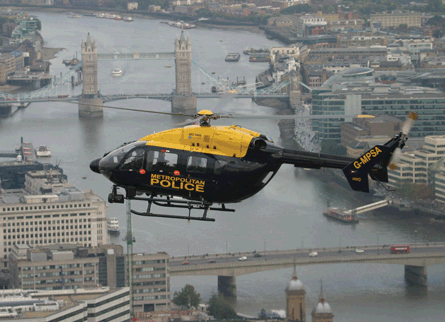They are a frequent sight in the skies above the cities and towns of the UK, but while police helicopters play a valuable part in supporting the provision of law and order, the operating model employed for their use has a surprisingly unruly feel to it.
Between them, the current 43 police authorities of England and Wales are responsible for a combined active fleet of 27 helicopters across four aircraft types, as recorded in Flightglobal's HeliCAS database. While small advances over recent years have seen some of the 29 air support units come together, for the large part the aircraft remain owned by individual forces and employed within their own geographical boundaries.
"If there is an incident just across the [force] boundary then surely the nearest aircraft should go," said Superintendent Richard Watson, project lead for the National Police Air Service (NPAS) scheme. "That is not how we currently operate, and that's wrong."
 |
|---|
© Metropolitan Police London's Metropolitan Police force operates the largest single fleet, with three Eurocopter EC145s |
A process to transform the system will start next April, when the new organisation will begin overseeing operations throughout England and Wales. While its initial integration phase will not be completed until mid-2013, the shift will come under immediate scrutiny as London prepares to host the Olympic Games from late July 2012.
The capital's Metropolitan Police force operates the largest single fleet, with three Eurocopter EC145s. Other aircraft in use around the remainder of the NPAS area include another EC145, six MD Helicopters MD902s and one AgustaWestland AW109E. The EC135 is the most commonly used type, however, with HeliCAS listing 16 in use with 15 operators.
Launched in 2009, the initiative to co-ordinate the use of these assets - which are currently funded to the tune of just over £60 million ($96 million) per year - is intended to deliver a more efficient service. Key elements will include centralised dispatch and "borderless tasking", with benefits to be felt in areas such as basing, maintenance, training and procurement.
"This is about delivering a better service to the people of the UK," said Watson. All 43 chief constables have backed the scheme, and by late last month 27 of the 28 responding authorities had approved the development, except for South Yorkshire. The remainder are due to give their backing by late November, Watson added.
Some co-ordination and rationalisation has already occurred. The south east air support unit, for example, combines the use of Surrey's EC135 and Sussex's MD902, and also covers for the retirement of Hampshire's fixed-wing Britten-Norman Islander.
In Sussex and Wiltshire the police also combine tasks with local air ambulance charities to deliver a 24h service. Meanwhile, other units in Merseyside and Norfolk have removed their helicopters from use.
"Public safety and public order are demands of air support, but we also need to recognise that there is an equally important demand in more rural areas," Watson said at Shephard's HeliPower conference in Farnborough, Hampshire on 20 October. "We need to make sure that all of those requirements are captured in NPAS," he added.
Dyfed Powys in Wales currently flies an AW109E, but has announced plans to replace this with a fixed-wing capability from 2013.
In the long-term, opportunities exist for police forces to do more with NPAS aircraft, and to potentially use a wider mix of types to introduce functions such as transport and reconnaissance. A larger helicopter acquired jointly could boost the ability to move firearms teams and other specialist units.
"A national service will provide national resilience, and allow us to think a little bit broader," Watson said. In time, this could even include combining activities with different agencies, such as the fire and health services, coastguard and other government users.
This long-term vision to create a cross-agency "blue light" service has already received support from industry groups.
"A light and medium [helicopter] mix could be suitable for meeting most requirements," said Richard Folkes, head of UK government and corporate affairs for airframer AgustaWestland.
Analysis conducted by the company has indicated that 98.5% of the search and rescue (SAR) missions flown in the UK between 2006 and 2010 could have been conducted using a helicopter in the 4,500kg (9,900lb) class, while 76% of the total sorties were flown inland.
The combined Maritime and Coastguard Agency (MCA) and Ministry of Defence SAR-H contract was cancelled early this year, removing plans to operate a fleet of Sikorsky S-92s under a 25-year private finance initiative deal with the Soteria consortium - comprised of CHC Helicopter, Sikorsky and Thales UK.
In July, the Department for Transport initiated the process to replace the MCA's current interim service, and the MoD requires a replacement for its Westland Sea Kings from 2016.
Noting that UK police, SAR and air ambulance fleets now total more than a combined 100 aircraft of 11 types used by 50-plus organisations, Folkes added: "can we really afford not to explore the options for a cross-government approach?"
Watson is in agreement: "Ultimately, there should be a national air service. If an aircraft is in the air then it should be doing the job for the nation."
Source: Flight International



















